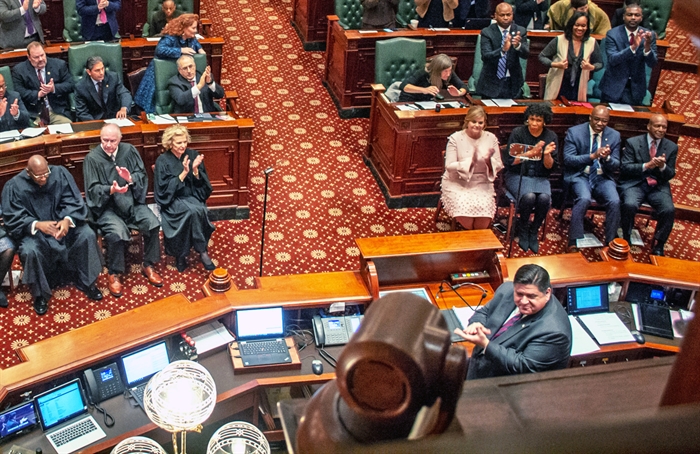Pritzker to mull tightening fiscal landscape in Wednesday’s budget address

Gov. JB Pritzker will give his sixth state budget address this week, laying out his plan for a fiscal year that government forecasters in November predicted is on pace for a near-$900 million deficit unless corrective action is taken.
Those same fiscal forecasters in the Governor’s Office of Management and Budget, however, predicted that the current fiscal year will end in a $1.4 billion surplus. That could create some leeway for the annual budget negotiating process that begins in February and usually concludes at the end of May.
The stark difference between the expected balances between fiscal years will make this year’s budgeting process a unique – and likely challenging – one, especially after a few years of better-than-expected revenues as the country avoided a post-pandemic recession.
While fiscal forecasters might advise socking away most of the $1.4 billion surplus as a cushion for the upcoming fiscal year, rank-and-file lawmakers nearly always view end-of-year balances as a potential funding source for their legislative priorities.
To top it all off, the November GOMB report identified another $969 million in current year “spending pressures.” Additional state assistance for thousands of newly arrived migrants in Chicago has been a headline pressure for months, but the state is also facing increased caseloads at the Department on Aging and the Department of Human Services, delays in certain federal reimbursements, increased group insurance costs, and outstanding technology bills.
That leaves about $400 million for other initiatives or to push forward as a balance in fiscal year 2025.
With those challenges in mind, here’s what to watch for as the governor makes his address to members of the General Assembly at noon on Wednesday.
How to watch: When the governor goes live, his speech can be found here.
The deficit plan
While the GOMB report provides a lens for the state’s current fiscal situation, it’s already three months old. A lot can change in a fiscal quarter to affect the budget outlook.
Notably, Pritzker’s GOMB has been a fairly cautious prognosticator. Its recent conservative estimates, combined with nationwide economic trends, have led to a string of surpluses.
Read more: Amid ‘unprecedented’ prolonged revenue boom, state finds budget breathing room
In November, GOMB projected spending to climb to about $52.3 billion in the upcoming fiscal year – a nearly $1.9 billion increase from what lawmakers approved in 2023. The spending expansion is driven by general across-the-board growth in most areas, led by K-12 education, human services, health care, pensions and government health insurance. Revenues were estimated at about $51.5 billion.
That makes for an estimated deficit of about $891 million for fiscal year 2025, which begins July 1. That figure falls to $721 million when excluding a planned $170 million infusion to the state’s “rainy day” long-term savings fund, which currently has a record-high balance over $2 billion.
Pritzker, for his part, has urged a “careful” approach, while also acknowledging revenue projections can quickly change.
“I think it’s a signal that everybody, we need to be careful in Illinois, we have to balance our budget…” Pritzker told Capitol News Illinois in December. “And so, if that requires us to reduce the increases that may occur in certain programs, maybe that will be necessary.”
Read more: ANALYSIS: Pritzker urges ‘careful’ approach as current-year surplus could be followed by deficit
If the projections hold, it likely means Pritzker and lawmakers will have to agree to slower spending growth or cuts to existing programs, new revenue streams, or some combination of those options.
There’s been no talk at the Capitol of any new or increased taxes, and the governor has all but abandoned his major push for a graduated income tax constitutional amendment that failed before voters in 2020.
Absent any major movement in revenue and spending estimates, Capitol News Illinois will be watching to see where Pritzker would suggest making up the revenue shortfall.
The reaction
Another thing to watch is how lawmakers respond to the governor’s remarks.
The state’s recent surpluses have generally eased budget negotiations in the past five years – at least compared to Illinois’ recent history that includes a two-year budget impasse between Pritzker’s Republican predecessor and Democrats in the General Assembly. An infusion of federal money helped every state plug budget holes during COVID’s early months in 2020 and had ripple effects on state economies in the following years as well.
Democratic leaders have historically been supportive of Pritzker on budget day, while also being unafraid to make their own pushes for initiatives they’d like to see bolstered or reduced.
But nuances in their reactions to the governor’s address can often be telling as to how negotiations will progress.
Last week, Pritzker announced plans to spend another $182 million in state money to respond to an influx of migrants in Chicago and Cook County that have been bused or flown to Illinois, primarily from Texas. It’s part of a joint $250 million funding infusion with Cook County that will provide shelter, health care and other services to the new arrivals.
Read more: Pritzker commits another $182 million to migrant response, details to come next week
The state, county and city response to the influx of migrants has been particularly controversial since Texas began transporting people from the southern U.S. border to so-called “sanctuary states” in August 2022. While Republicans have frequently called for Illinois to make drastic changes to its immigrant-related policies, Democrats have been more receptive to Illinois’ “welcoming” response – despite some consternation about spending hundreds of millions of dollars on programs for new arrivals rather than shoring up existing programs.
Senate President Don Harmon, D-Oak Park, praised the governor for “initiating this needed team approach” – but he also gave a glimpse into his chamber’s budget priorities.
“I’m eager to hear more about the governor’s proposed budget and look forward to continued discussions on pairing expenditures on this crisis with investments in longstanding issues facing our communities like homelessness, food insecurity and job opportunities,” he said in a statement.
Pritzker’s only bipartisan budget came during his first year in office – when a massive infrastructure package garnered dozens of GOP votes and helped create goodwill for some House Republicans to vote for the budget. Republicans have been opposed to every budget since, though every winter they’ve insisted they have renewed hope to pass a bipartisan budget.
That expressed desire seemed possible last year as both the House and Senate minority leaders were new to their posts. But the GOP soured on working with Democrats on the budget as the spring wore on, claiming they were shut out of negotiations completely. With their supermajorities at record numbers, Democrats don’t need GOP votes to pass a budget.
House Republican Leader Tony McCombie told Capitol News Illinois last month that her budget team this year is sitting down with Pritzker’s staff, saying it was a strategic move to bypass House Speaker Emanuel “Chris” Welch’s team.
“If we show our cards, everything will be excluded,” she said. “(Democrats) talk about (the budget) being a moral document, but it is a political document.”
Noncitizen health care
While sailing has generally been smooth for the Democrats in power, one noticeable point of contention in last year’s budget was the question of how much funding should be allocated to a pair of state-funded health care programs for noncitizens.
The Health Benefits for Immigrant Seniors and Adults programs provide Medicaid-like benefits to individuals aged 42 and over who would otherwise be eligible for the joint federal-state low-income health care program if not for their immigration status.
Last year, the governor’s office projected the state’s costs to exceed $1 billion if the programs were unchanged.
Ultimately, legislators decided to allocate $550 million for the programs while giving the governor the authority to cap enrollment and put in place other cost-saving measures.
“The legislature said, ‘we don’t want to actually make any decisions about that. So here, governor, you figure it out,’” Pritzker said at a Feb. 9 news conference. “And that’s part of my job is to take on big problems and big challenges and get things done. And so we did.”
The program has been the biggest contention for Republican lawmakers, while some Democrats have been reluctant to support it. The Illinois Legislative Latino Caucus and some immigrant and health care advocates, however, have pushed for its expansion and for it to be reopened for enrollment.
Whether or not it will be reduced, expanded or cut could prove to be a contentious point once again.
Education
State spending on PreK-12 education and higher education currently totals about $13 billion, or one-fourth of all general revenue fund budget, making it the state’s largest area of discretionary spending. Yet despite the fiscal pressures Illinois faces in the coming year, both of those systems are seeking substantial funding increases.
In January, the Illinois State Board of Education approved a budget request of just over $11 billion, an increase of $653 million, or 6.3 percent over the current year.
Read more: State education board to seek $653M increase in upcoming budget year
The largest portion of that is a $350 million increase in Evidence-Based Funding. That’s the minimum increase called for each year under a 2017 law that seeks to bring all 852 school districts in Illinois up to an adequate level of funding by earmarking new money for the districts that need it most.
The proposal also includes a $75 million increase for early childhood education to fund the second year of Pritzker’s Smart Start Illinois initiative, which seeks to expand access to preschool and child care services by 20,000 seats over four years and increase wages for early childhood workers.
Additionally, it calls for a $10 million increase in career and technical education and $35 million in new funding for educational support services for migrants arriving in Illinois.
The Illinois Board of Higher Education, meanwhile, is seeking a $179 million increase, or 6.8 percent, which would bring total state support for higher education, not including pension contributions, to $2.6 billion.
That includes a 5 percent increase in operating funds for public universities and community colleges, as well as a $50 million increase in Monetary Award Program, or MAP grants, the state’s need-based financial aid program for college students.
Additional reporting by Peter Hancock and Hannah Meisel.
Capitol News Illinois is a nonprofit, nonpartisan news service covering state government. It is distributed to hundreds of newspapers, radio and TV stations statewide. It is funded primarily by the Illinois Press Foundation and the Robert R. McCormick Foundation, along with major contributions from the Illinois Broadcasters Foundation and Southern Illinois Editorial Association.
Miss Clipping Out Stories to Save for Later?
Click the Purchase Story button below to order a print of this story. We will print it for you on matte photo paper to keep forever.

